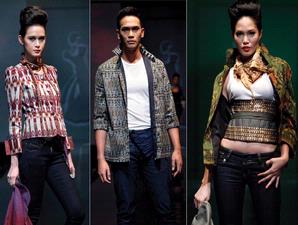
Sumba, one of the major islands in East Nusa Tenggara, is renowned as a center of textile-weaving. As is commonplace in East Nusa Tenggara, Sumbanese fabric holds a special place in the locale’s daily lives: they are used as clothes, in cultural ceremonies, as a medium of spiritual worship, an economic commodity, and a variety of other uses.
In times long past, the
Sumbanese people are divided into three strata: the nobility (
maramba), the commoners (
kabihu), and the servants (
atangadi), who are drafted from war prisoners. The fabrics worn by each person can be used to identify their social status: some colors and patterns are usable only by the nobility, while others may be used freely by the commoners. On the other hand, members of the servant caste are not permitted to don fabrics of any kind—instead, they are only allowed to wear clothes made of tree bark.
 Sumbanese
Sumbanese fabrics are typically known to feature two dominant colors: an indigo blue derived from the indigo plant (
indigofera tinctoria) and a rust-like shade of brown derived from the noni fruit (morinda citrifolia). Another common color is hazelnut yellow, which is extracted from turmeric (
curcuma domestica) or hazelnuts (
aleurites moluccana).
The patterns predominantly featured in
Sumbanese textiles are inspired from the people’s direct surroundings. These include a variety of seaside animals, such as fishes, squids, shrimps, or seahorses. Land animals such as horses, chickens, deers, birds, and snakes, are also commonly featured in
Sumbanese textile.

Two well-known types of
Sumbanese fabrics are
hinggi and
lau.
Hinggi is a long piece of fabric extending some two meters in length meant to be worn by adult males. It can function as a blanket, shawl, or a piece of cloth tied around the waist.
Hinggi is often worn by
Sumbanese men during cultural ceremonies. There are two main types of
hinggi:
hinggi kombu rara, which is reddish-brown in color, and
hinggi kaworu, which is predominantly blue. In the past, the color of
hinggi could be used to identify the wearer’s social status: blue-and-white
hinggi are typically used by the common man, while reddish-brown
hinggi are exclusive to nobility and royalty. Even so,
Sumbanese kings typically don a plain black piece of fabric, which symbolizes power and authority.

Meanwhile,
lau is a type of ikat featuring additional songket techniques, which results in an embroidery-like texture on the produced fabric. It is typically used as a sarong by
Sumbanese females. Several traditional
lau are also interwoven with small beads or seashells—these lau are called
lau katipa, which are rarely produced nowadays.
Lau is typically dyed a combination of dark blue, purple, and black, or a combination of brown and dark red. It commonly features birds, lizards, newts, shrimps, scorpions, and other animalistic patterns.
Other common patterns depict the
andung tree, which is a tree with eight skulls hanging from its branches. It is a representation of the ancient
Sumbanese, who are believed to have travelled to eight places before finally reaching
Sumba. The tree itself is known as the
hayat tree, or the tree of life, which represents the eternal afterlife. The
hayat tree is a pattern used not only in
Sumba, but also in various places throughout Indonesia.
 Sumbanese
Sumbanese textile has received a considerable amount of influence from foreign cultures. For example, the Chinese, who came to
Sumba to trade their china for horses, spices, and sandalwood, have inspired
Sumbanese artisans to incorporate dragon patterns into their fabrics. Islamic influences are also very apparent in some pieces; for example,
bourag—the
pegasus steed of the
Prophet Muhammad—is woven into some of the
Sumbanese men’s
hinggi. European influences such as the lion—symbol of the Dutch and Portuguese—are also present in some fabrics; these are thought to be crafted in order to satisfy the demands of European traders, who utilize
Sumbanese textile as interior decoration.

Today,
Sumbanese textiles are used for more than just cultural ceremonies, but also as a valuable trade commodity. They are internationally exported, highly demanded by tourists, utilized in art shops, and are used as interior decorations in five-star hotels. However, due to its rise to fame as an artistic commodity, some of
Sumba’s most complex traditional patterns, which consumes a lot of time, energy, and resources to create, have completely disappeared. As the demand for
Sumbanese textile rise, the artisans are forced to produce textiles faster, leading to a sharp decrease in quality. Nowadays,
Sumba’s best fabrics are instead showcased in various European and American museums. It is the hope of
Sumbanese textile observers that in years to come, the artisans can again reach the quality of the fabrics displayed in these collections.
Article Source:
http://artscraftindonesia.com/Image Sources:
http://www.backpackerindonesia.com/www.itrademarket.comhttp://www.tenunindonesia.com/www.moripanet.comhttp://female.kompas.com